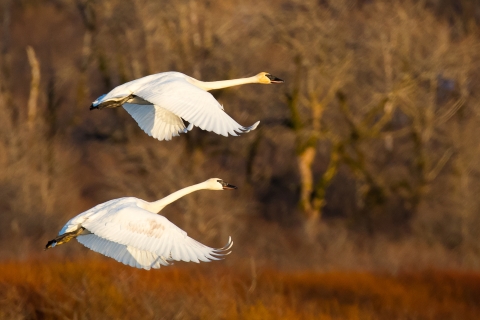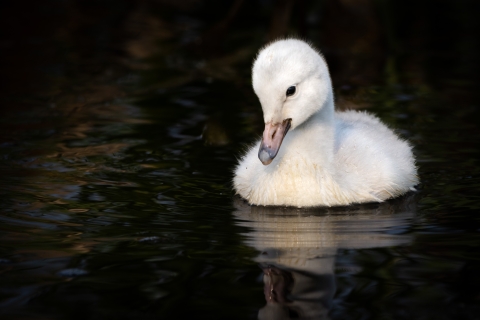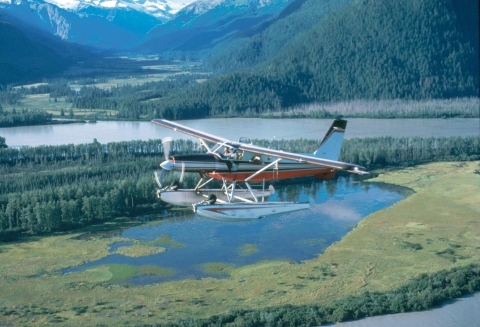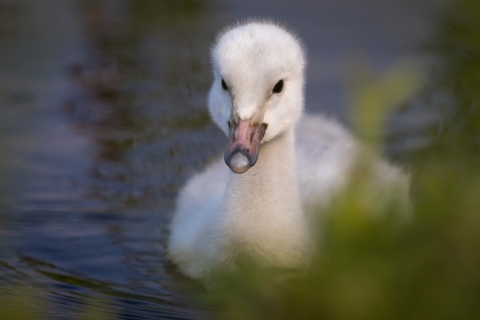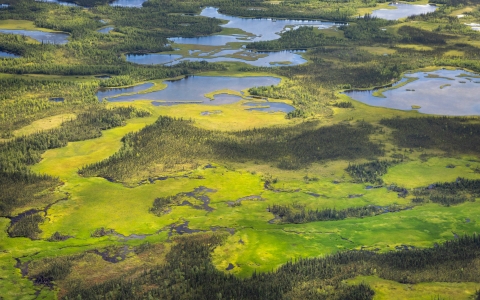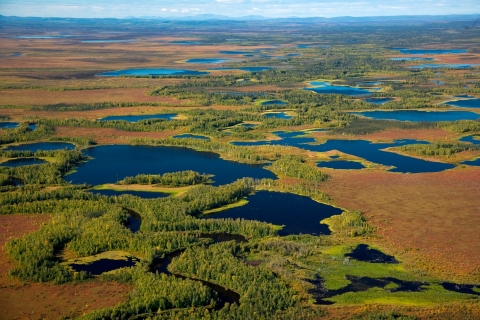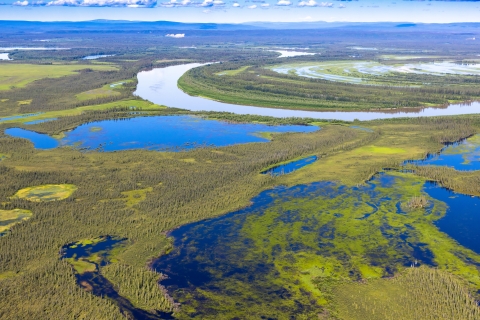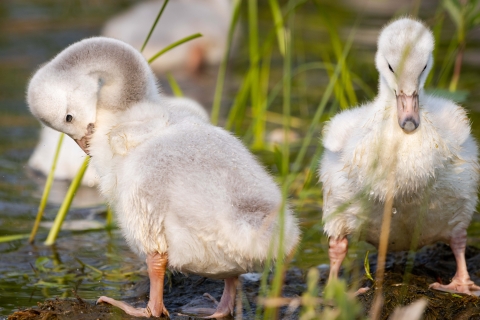It’s a crisp fall morning in Alaska’s boreal forest. Bright gold birch leaves drift down, and mist rises from the edge of a quiet lake. Against the backdrop of mountains, resonant calls begin to echo and grow closer: ko-HOH, ko-HOH, ko-HOH.
In a sweep of enormous white wings, a flock of trumpeter swans glide down onto the water. They pause here to rest and forage before taking flight to wintering grounds, joining large flocks of swans among the farms and fields of Washington State.
Threatened with silence
One hundred years ago, the song of the trumpeter swan faced the potential of permanent silence.
On December 15th, 1924, a stark press release from the Department of Interior announced a dramatic action based on the recommendation of the U.S. Biological Survey (predecessor to the U.S. Fish and Wildlife Service):
“Trumpeter swans, very few of which are in existence, will be given complete protection in the United States…”
Prized for their feathers and skins, these majestic birds had faced relentless hunting pressure since the eras of the fur trade and early European colonial period in North America. By the early 1930s, surveys in the contiguous United States revealed a grim reality: in 1935, scientists knew of only 69 trumpeter swans in existence.
First notes of recovery and new hope from Alaska
A broad conservation movement began to take flight with the 1918 Migratory Bird Treaty Act, protecting swans and other migratory birds. President Franklin D. Roosevelt took action in 1935, establishing Red Rock Lakes National Wildlife Refuge to safeguard a remote wetland near Yellowstone where most of the known remaining birds nested. Restoration programs began successfully transplanting swans from Red Rock Lakes to refuges in Wyoming, Oregon, and Nevada.
While the population in the lower 48 states inched towards recovery, Alaska's vast landscape offered another glimmer of hope: scientists had long believed that the remote areas of Canada and Alaska might hold secret stashes of trumpeter swans... However, the same rugged terrain that potentially harbored unknown swan populations also hindered biologists' efforts to locate and count them.
In the 1950s, scientists documented trumpeter swans at some wildlife refuges in Alaska, including a handful of nesting pairs on the Kenai Moose Range (later the Kenai Refuge). The picture became more complete in 1968, when the late Jim King led the first comprehensive aerial survey of Alaska’s trumpeter swans, counting 2,847 birds.
The results from this Alaska survey and the success from collaborative restoration efforts in the lower 48 led to a proud announcement of the trumpeter swan’s removal from the federal list of “rare wildlife species” later that year:
“This is an example of conservation interests bringing about an action program that successfully prevented the loss of one of America's greatest wildlife species…and we are proud of the role our refuges have played in this restoration.”
- Dr. Gottschalk, Director of the Bureau of Sport Fisheries and Wildlife (Department of Interior Press Release, December 1968).
A growing crescendo across Alaska
From prime wetlands for nesting to strategic migration staging areas, national wildlife refuges in Alaska host some of the best trumpeter swan habitat for over half of the continent's population. Journey with us to four refuges that showcase the dramatic shift in the triumphant recovery of the trumpeter swan:
KENAI
Paddle quietly through the Swan Lake Canoe Trail and you are likely to see at least one pair of wild trumpeter swans gliding through the marsh. Efforts to protect swans at Kenai National Wildlife Refuge have included careful management actions over many years to minimize human disturbance of breeding areas.
Biologists began surveying for swans on the refuge in 1957. Later, researchers like Ted Bailey pioneered innovative tracking methods. Between 1982 and 1985, Bailey and his team tracked 45 trumpeter swans using VHF radio transmitters to better understand their movements and behavior.
One particularly adventurous swan, an adult female captured on Kenaitze Lake, traveled more than 1,400 miles to Barney Lake in Washington State between September 17 and December 2, 1984. This discovery highlighted the importance of protecting not just breeding grounds, but also migration routes and wintering areas. Re-sighting of the banded Kenai swans on Barney and Skagit Lakes led to proactive conservation measures to protect these areas and reduce the use of lead in waterfowl hunting, many years before a nationwide mandate.
TETLIN
If you cruise the Al-Can Highway from Canada into Alaska and along the border of Tetlin National Wildlife Refuge, scan the wetlands along the road for graceful white silhouettes. With ideal nesting habitat and a major migratory route through mountain ranges, the refuge has seen remarkable growth of its trumpeter swan population.
In 1980, when the refuge was established, biologists had documented just a handful of swans in the area. The first comprehensive swan survey in 1985 recorded only 97 adults.
A subsequent population explosion defied even the most optimistic expectations. In just three decades—a mere moment in evolutionary time—the swan population in the Upper Tanana Valley soared to nearly 2,000 birds. The earlier years showed the greatest increase in numbers, and biologists theorize that Tetlin may have reached its capacity for more growth as swans encounter a kind of "housing crisis," where all the best nesting areas are already occupied.
KANUTI
Kanuti National Wildlife Refuge, with its mosaic of wetlands, boreal forest, and tundra, is at the northwestern edge of the range for nesting trumpeter swans in Alaska. The refuge also provides important nesting areas for the smaller tundra swan.
Similar to Tetlin's trumpeter swan population, Kanuti's has grown exponentially over the past 30 years. Biologists have also noticed another trend: a shift from nearly an equal proportion of nesting tundra and trumpeter swans to a ratio of nearly 95% trumpeters!
Read more about swan surveys on Kanuti Refuge
KOYUKUK
Just to the southwest of Kanuti, the lower Koyukuk River winds through the wetlands and forest of Koyukuk National Wildlife Refuge on the way down to the Yukon River. The initial surveys that began in 1968 seemed to show trumpeter swans "pioneering" into sparsely occupied habitat areas in what later became Innoko and Koyukuk Refuges. Later surveys estimated increasing overall numbers of trumpeter swans and a shifting trend to more trumpeter nests than tundra swan nests, similar to Kanuti.
One potential explanation for this surge in numbers into more northern territory? A warming climate with a longer summer season that benefits trumpeter swans for successful nesting and rearing of cygnets. But beyond the changing climate, we might also be witnessing a return of trumpeter swans to areas they once occupied before the decimation of earlier centuries.
The refuge, which was established in 1980, has very little record of the historical breeding ranges for either swan species in the region. In some interviews, Alaska Native Elders in the Koyukuk area reported familiarity only with the call of the tundra swan. However, traditional stories hint at a possibly different past. One tale recounts a time "when beasts were men," describing how the swan lost its melodious voice after losing a fight with the K'etsetl (green-winged teal duck), leaving it with "but a pitiful cry" (Jette and Jones 2000). Bryant et al. (2005) discuss in their refuge report that this story might reflect a different time period when trumpeter swans, known for their resonant calls, were more prevalent in the area but then disappeared.
A triumphant chorus
Today, the skies and waters of Alaska are home to more than 20,000 trumpeter swans. Many other states have successfully restored swans to their former range. This remarkable resurgence showcases the effectiveness of conservation initiatives and the crucial role of protected habitats.
So, the next time you're near an Alaskan lake and a cascade of trumpeting calls breaks the silence, pause for a moment. That cadence of ko-HOH, ko-HOH is more than just birdsong. You're witnessing the echoes of a heroic survival story.
Resources:
Bryant, J.M., Scotton, B.D., & Hans, M.R. (2005). Sympatric Nesting Range of Trumpeter and Tundra Swans on the Koyukuk National Wildlife Refuge in Northwest Interior Alaska (Progress Report FY-05-02). U.S. Fish and Wildlife Service, Koyukuk/Nowitna National Wildlife Refuge Complex.
Bryant, J., Mallek, E., & Harwood, C. (2021). Sympatric Nesting Range of Trumpeter and Tundra Swans on the Kanuti National Wildlife Refuge in Northwest Interior Alaska, 2019 (Progress Report FY-2021). U.S. Fish and Wildlife Service, Koyukuk/Nowitna/Innoko National Wildlife Refuge Complex & Kanuti National Wildlife Refuge.
Conant, Bruce, John I. Hodges, and James G. King. "Continuity and Advancement of Trumpeter Swan Cygnus buccinator and Tundra Swan Cygnus columbianus Population Monitoring in Alaska." Wildfowl, Supplement No. 1, 1991, pp. 125–136.
Conant, B., J.I. Hodges, D.J. Groves, and J.G. King. "Census of Trumpeter Swans on Alaskan nesting habitats, 1968-2000." Waterbirds, vol. 25, Special Publication 1, 2002, pp. 3-7.
Doyle, T. J. "Expansion of trumpeter swans in the Upper Tanana Valley, Alaska." Proceedings and Papers of the Fourteenth Trumpeter Swan Society Conference, edited by Donna C. Compton, Madeleine H. Linck, and Harvey K. Nelson, The Trumpeter Swan Society, Courtenay, British Columbia, 1993, pp. 192-197.
DuBour, K. 2017. Thirty Years of Swan Surveys at Tetlin National Wildlife Refuge
(1985-2015). U.S. Fish and Wildlife Service. Tetlin National Wildlife Refuge, Tok, AK.
Groves, Deborah J. "The 2015 North American Trumpeter Swan Survey: A Cooperative North American Survey." U.S. Fish and Wildlife Service, Migratory Bird Management, Juneau, Alaska, USA, 2017.
Hansen, Henry A., Peter E. K. Shepherd, James G. King, and Willard A. Troyer. "The Trumpeter Swan in Alaska." Wildlife Monographs, no. 26, Oct. 1971, pp. 3-83. Published by: Wiley on behalf of the Wildlife Society.
Harwood, C. "Trumpeter Swan Surveys, Kanuti National Wildlife Refuge." Poster presentation.
Morton, John. "Where Do Our Trumpeter Swans Go in the Winter?" Peninsula Clarion, 9 Nov. 2016, https://www.peninsulaclarion.com/life/refuge-notebook-where-do-our-trumpeter-swans-go-in-the-winter/.
Schmidt, J. H., M. S. Lindberg, D. S. Johnson, and D. L. Verbyla (2011). Season length influences breeding range dynamics of trumpeter swans Cygnus buccinator. Wildlife Biology 17:364–372.
Shea, Ruth E., Harvey K. Nelson, Laurence N. Gillette, James G. King, and David K. Weaver. "Restoration of Trumpeter Swans in North America: A Century of Progress and Challenges." Waterbirds, vol. 25, Special Publication 1: Proceedings of the Fourth International Swan Symposium 2001, 2002, pp. 296-300. Published by: Waterbird Society.


